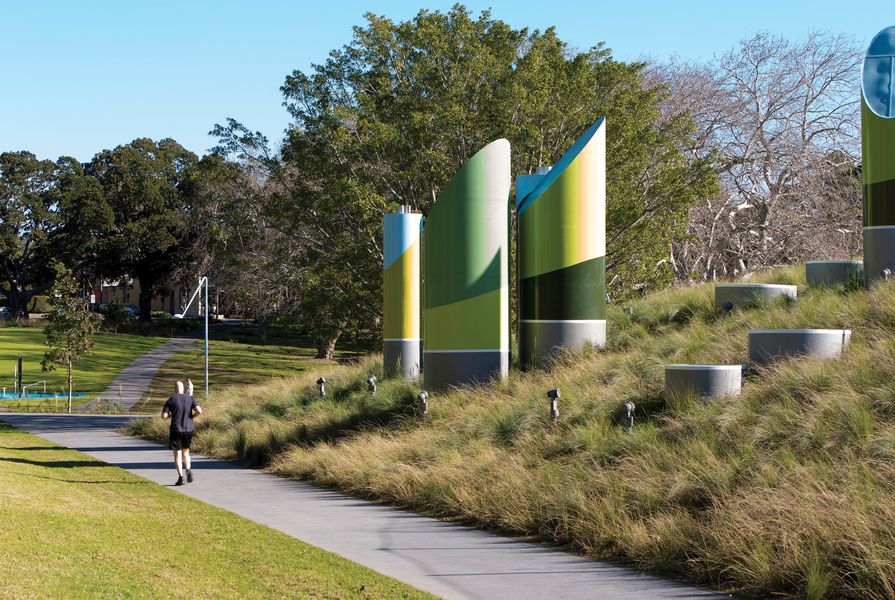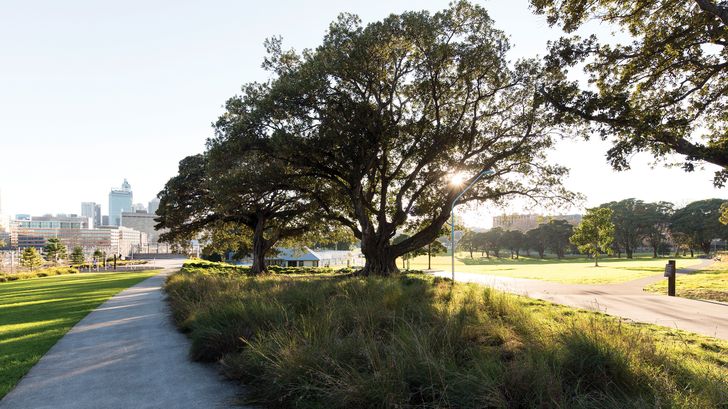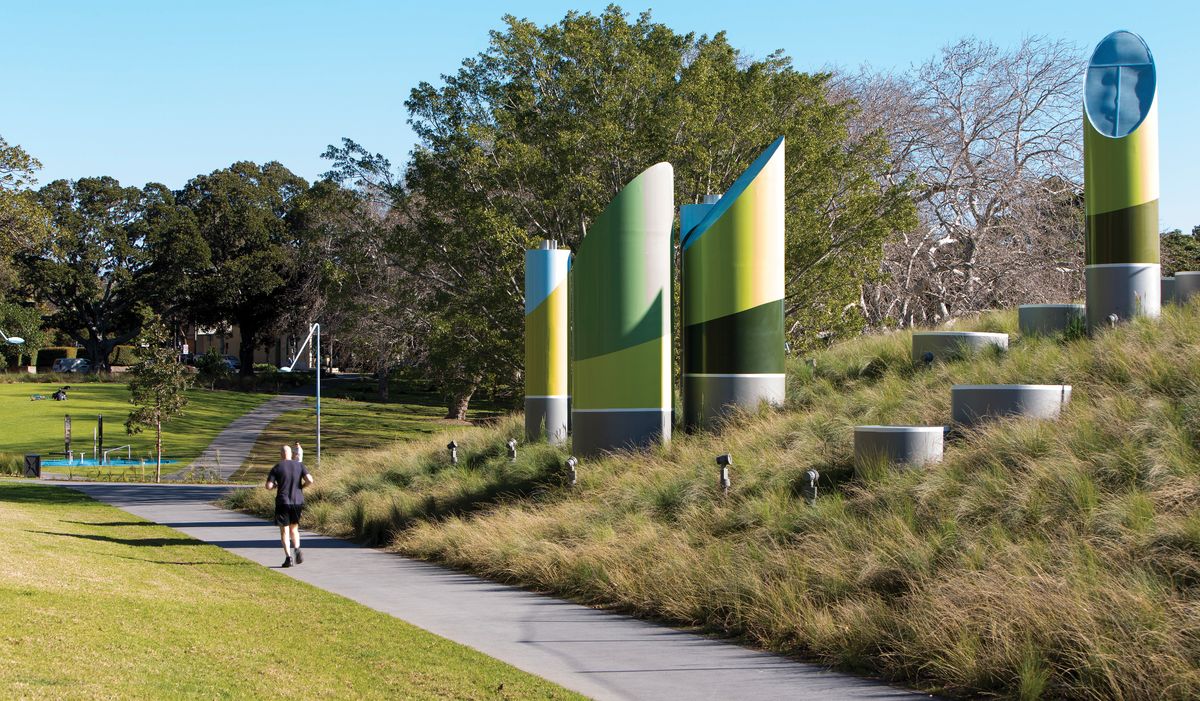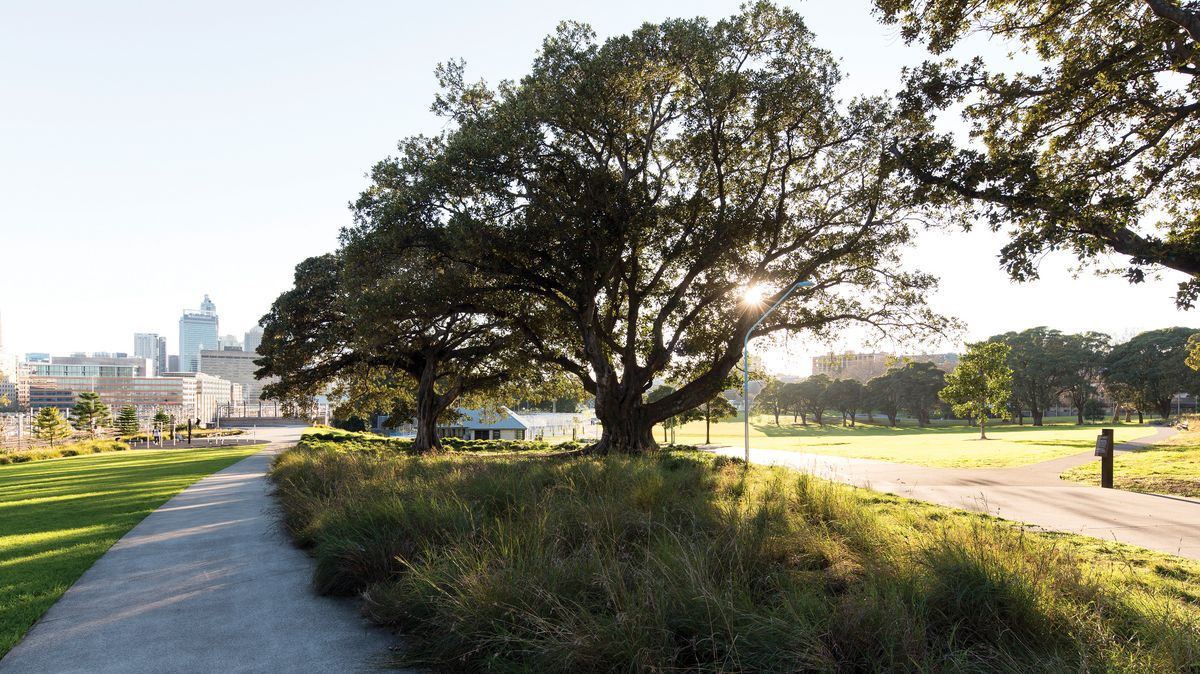Prince Alfred Park, a 7.5-hectare park in inner Sydney, needs little introduction. Reinvigorated in 2013 by Sue Barnsley Design and Neeson Murcutt Architects for the City of Sydney, the multi-award-winning project has been roundly celebrated and become a treasured open space for the city. While the park’s innovations and inclusions have been thoroughly discussed, its implications, especially in regard to planting design, have received considerably less attention.
The project began in 2006 after a period of drought, when the park languished with stressed mature trees and little variety in underplanting. The figs, planted circa 1870 along Cleveland Street, struggled with psyllid attacks while newer tree plantings were damaged by insensitive maintenance.1 The planting scheme proposed for the park, most notably the green roof to the rethought pool and the native meadow bordering Cleveland Street, were attempts to add complexity and nuance to a tired site, and to add an ecological element to the design. In the case of the seemingly humble native meadow, planting design has been used to engage with an even more neglected aspect of planting – that of culture.
The native meadow in this location can be read as a subtle argument for the validity and place of endemic planting within the confines of the historic, largely Victorian-period parks of central Sydney, particularly in its siting along a major view line into the park. From Cleveland Street, the view to a gently rolling traditional lawn is now framed by the sometimes brown, sometimes golden native seed heads, adding a layer of complexity both to the park’s overall planting and to the range of ways we view the appropriateness of grasslands within our parks.
From Cleveland Street, the view to a traditional lawn is now framed by the sometimes brown, sometimes golden native seed heads of the meadow plantings.
Image: Brett Boardman
Incorporating native grasses in public spaces required a shift in attitude regarding maintenance, a questioning of the urge to mow and trim and a reconsideration of the idea of grassed areas as ecologically and temporally potent spaces, rather than static swathes of green. Potential grassland species were tested on site in patches, trialling issues of resiliency, speed of growth and competition. In some cases, unexpected plants such as Wahlenbergia stricta (Australian bluebells) emerged, suggesting a layered history lying dormant in the site’s seed bank. The short-lived experiments indicated a desire to engage with ecological processes, making visual the elements of diversity and seasonality pregnant in the design and species selection. The test patches were a gesture toward understanding plant behaviour in a site-specific context – most exotic grass species behave as annuals, flowering in winter or spring, while natives are largely summer-flowering perennials.2 An argument was developed in regard to maintenance: that while the meadow would require weeding, rather than mowing, the underplanting proposed for the mature figs would ameliorate issues of compaction, retaining moisture and moderating soil temperature – a bargain struck.
The idea of un-mowed grasses proved surprisingly contentious. When I spoke with Sue Barnsley she described calls received by the local council in which irate taxpayers demanded to know why the “lawn” was going un-mowed, the park lacking adequate maintenance for its prominence. The calls resulted in the addition of a sign and a naming of the space, “native meadow,” to communicate that the “loose” effect of the sometimes browning, blowzy windblown grasses was intentional and designed.
Naming, even reluctantly, is important.3 The term “meadow” communicates a pastoral, romantic vision. Prefacing it with “native” as an adjective seems an attempt to make the effect of the messy (in certain opinions) plantings palatable, by equating endemic grassland with a historic, less threatening and more familiar typology. The assertion may seem tenuous, but consider how limited our language is in conveying a depth of potential, in the narrow way we define a positive result in relation to planting design. The exhausted words bandied about – lush, green, rich – wouldn’t describe a native meadow and outline a set of outcomes that are narrower than what landscape architects are capable of delivering.4
In a broader sense, these words communicate and construct imagery that excludes endemic or native planting – feeding a hard-to-sustain addiction to verdure over the potential for something subtle, changing, seasonal or unpredictable. In a beautiful book underpinned by a fierce linguistic obsession, What is Landscape?, John R. Stilgoe suggests that the term meadow “names openness,” or describes spaces that act as “landing strips for sunlight,” both apt and flexible descriptions of the experience of a place defined by planting – descriptions crucially focused on experience more than on appearance. In the absence of an extensive professional nomenclature, it is clear that the words we employ to describe planting design are necessarily both generative and limiting.
Beyond necessitating a name, the vocal (if limited) public reaction to the meadow not only implies an aversion to a particular planting typology (a kind of horticultural cringe), but also hints at a collective cultural or aesthetic amnesia. This relates not only to the specific history of the site, in its previous incarnation as Cleveland Paddocks, and the echoes of that space the meadow may evoke, but also to the broader, largely erased landscape history of Sydney.
Themeda, whose distinctive seed heads punctuate the planting, is considered to be Australia’s most widespread grass genus prior to European settlement and its colour, predominantly a summer tan, considered the defining colour of the country.5 In the case of the meadow, a low and varied carpet of grasses with clear sightlines beneath majestic figs may seem ecologically incongruous, but it is remarkably similar to the earliest descriptions of Sydney’s landscape. These landscapes, described so often as appearing like a “gentleman’s park,”6 were noted as the favoured landscapes of the Aboriginal Eora people.7 Largely erased from Sydney, they can be considered the city’s “lost landscapes.”8 The negative reaction to the opportunities the native meadow provides – witnessing seasonal changes, the succession of species over time – subtly highlights our ignorance about Sydney’s seasons and particularities.
If we accept the argument that landscapes accrue their power, in opposition to other mediations between nature and culture, temporally,9 where better in our designs to express this quality than in planting? When the elements that distinguish landscape from related disciplines – an engagement with ecology and the temporal, a sometimes unfashionably earnest consideration of genius loci – are avoided in favour of green veneers, our promotional claims of ecological stewardship ring slightly hollow. Planting design in landscape architecture has more to answer to and more to offer than mere decoration or even ecology; it plays an active role in contributing to the meaning of place. The potential for landscape to intelligently reflect on prevailing concepts of nature, rather than simply restoring or re-creating past ecologies, provides a rich area for debate, especially in an Australian context.10 The role of planting in contextualization, by engaging with memory and the temporal, can ameliorate the perceived lack of intellectual and emotive depth of the profession.11
For more coverage (and project credits) on Prince Alfred Park, see Julian Raxworthy’s review in Landscape Architecture Australia 141, February 2014.
Plant list – Cleveland Street meadow
Deep shade
Dianella caerulea (blue flax-lily)
Dichondra repens (kidney weed)
Microlaena stipoides (weeping grass)
Viola hederacea (Australian native violet)
Sun shade
Cymbopogon refractus (barbed wire grass)
Dichondra repens (kidney weed)
Eragrostis elongata ‘Elvera’ (lavender grass)
Microlaena stipoides (weeping grass)
Themeda australis (kangaroo grass)
Viola hederacea (Australian native violet)
Wahlenbergia stricta (Australian bluebell)
1. Warwick Mayne-Wilson, “The rise, decline and transformation of Sydney’s parks: three case studies,” Australasian Parks and Leisure, vol 9 no 4, summer 2006,12–16.
2. Bill Gammage, The Biggest Estate on Earth: How Aborigines made Australia (Crows Nest, NSW: Allen and Unwin, 2011), 32.
3. John R. Stilgoe, What is Landscape? (Cambridge, Mass.: MIT Press, 2015), 5.
4. Marc Treib, Austere Gardens: Thoughts on Landscape, Restraint, and Attending (Novato, California: Oro Editions, 2016), 24.
5. Bill Gammage, The Biggest Estate on Earth , 32.
6. Richard Aitken, Planting Dreams: Shaping Australian Gardens (Sydney: NewSouth Books, 2016), 4.
7. Grace Karskens, The Colony: A History of Early Sydney (Crows Nest, NSW: Allen and Unwin, 2009), 46, 58.
8. Grace Karskens, The Colony , 21.
9. James Corner, “Recovering Landscape as a Critical Cultural Practice” in James Corner (ed), Recovering Landscape: Essays in Contemporary Landscape Architecture (New York, NY: Princeton Architectural Press), 1999, 13.
10. James Corner, “Representation and Landscape: Drawing and Making in the Landscape Medium” in Word and Image, vol 8 issue 3, 1992, 144.
11. James Corner, “Recovering Landscape as a Critical Cultural Practice,” 13.
Source
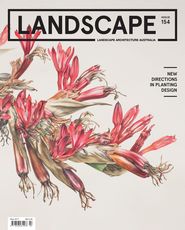
Review
Published online: 12 Oct 2017
Words:
David Whitworth
Images:
Brett Boardman
Issue
Landscape Architecture Australia, May 2017

